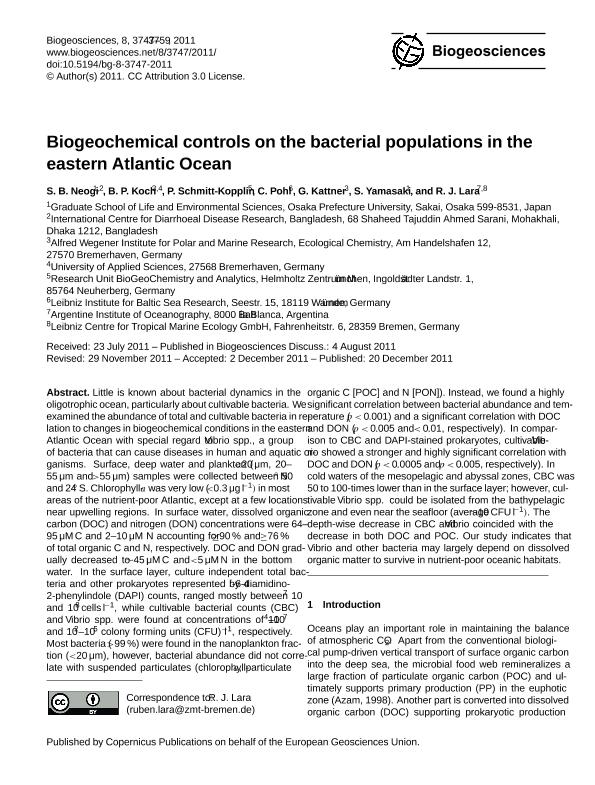Mostrar el registro sencillo del ítem
dc.contributor.author
Neogi, Sucharit Basu

dc.contributor.author
Koch, Boris Peter

dc.contributor.author
Schmitt Kopplin, Philippe

dc.contributor.author
Pohl, Christine
dc.contributor.author
Kattner, Gerhard
dc.contributor.author
Yamasaki, Shintaro
dc.contributor.author
Lara, Ruben Jose

dc.date.available
2017-08-14T17:26:40Z
dc.date.issued
2011-07
dc.identifier.citation
Neogi, Sucharit Basu; Koch, Boris Peter; Schmitt Kopplin, Philippe; Pohl, Christine; Kattner, Gerhard; et al.; Biogeochemical controls on the bacterial population in the eastern Atlantic Ocean; Copernicus Publications; Biogeosciences; 8; 7-2011; 3747-3759
dc.identifier.issn
1726-4170
dc.identifier.uri
http://hdl.handle.net/11336/22291
dc.description.abstract
Little is known about bacterial dynamics in the oligotrophic ocean, particularly about cultivable bacteria. We examined the abundance of total and cultivable bacteria in relation to changes in biogeochemical conditions in the eastern Atlantic Ocean with special regard to Vibrio spp., a group of bacteria that can cause diseases in human and aquatic organisms. Surface, deep water and plankton (<20 µm, 20– 55 µm and >55 µm) samples were collected between 50◦ N and 24◦ S. Chlorophyll-a was very low (<0.3 µg l−1 ) in most areas of the nutrient-poor Atlantic, except at a few locations near upwelling regions. In surface water, dissolved organic carbon (DOC) and nitrogen (DON) concentrations were 64– 95 µM C and 2–10 µM N accounting for ≥90 % and ≥76 % of total organic C and N, respectively. DOC and DON gradually decreased to ∼45 µM C and <5 µM N in the bottom water. In the surface layer, culture independent total bacteria and other prokaryotes represented by 40 -6-diamidino- 2-phenylindole (DAPI) counts, ranged mostly between 107 and 108 cells l−1 , while cultivable bacterial counts (CBC) and Vibrio spp. were found at concentrations of 104–107 and 102–105 colony forming units (CFU) l−1 , respectively. Most bacteria (>99 %) were found in the nanoplankton fraction (<20 µm), however, bacterial abundance did not correlate with suspended particulates (chlorophyll-a, particulate organic C [POC] and N [PON]). Instead, we found a highly significant correlation between bacterial abundance and temperature (p < 0.001) and a significant correlation with DOC and DON (p < 0.005 and < 0.01, respectively). In comparison to CBC and DAPI-stained prokaryotes, cultivable Vibrio showed a stronger and highly significant correlation with DOC and DON (p < 0.0005 and p < 0.005, respectively). In cold waters of the mesopelagic and abyssal zones, CBC was 50 to 100-times lower than in the surface layer; however, cultivable Vibrio spp. could be isolated from the bathypelagic zone and even near the seafloor (average ∼10 CFU l−1 ). The depth-wise decrease in CBC and Vibrio coincided with the decrease in both DOC and POC. Our study indicates that Vibrio and other bacteria may largely depend on dissolved organic matter to survive in nutrient-poor oceanic habitats.
dc.format
application/pdf
dc.language.iso
eng
dc.publisher
Copernicus Publications

dc.rights
info:eu-repo/semantics/openAccess
dc.rights.uri
https://creativecommons.org/licenses/by/2.5/ar/
dc.subject
Atlantic
dc.subject
Oligotrophic
dc.subject
Doc-Iron
dc.subject
Bacteria
dc.subject.classification
Oceanografía, Hidrología, Recursos Hídricos

dc.subject.classification
Ciencias de la Tierra y relacionadas con el Medio Ambiente

dc.subject.classification
CIENCIAS NATURALES Y EXACTAS

dc.title
Biogeochemical controls on the bacterial population in the eastern Atlantic Ocean
dc.type
info:eu-repo/semantics/article
dc.type
info:ar-repo/semantics/artículo
dc.type
info:eu-repo/semantics/publishedVersion
dc.date.updated
2017-07-13T14:40:05Z
dc.identifier.eissn
1726-4189
dc.journal.volume
8
dc.journal.pagination
3747-3759
dc.journal.pais
Alemania

dc.journal.ciudad
Gottingen
dc.description.fil
Fil: Neogi, Sucharit Basu. Osaka Prefecture University; Japón. International Centre for Diarrhoeal Disease Research; Bangladesh
dc.description.fil
Fil: Koch, Boris Peter. Alfred Wegener Institute for Polar and Marine Research; Alemania. University of Applied Sciences; Alemania
dc.description.fil
Fil: Schmitt Kopplin, Philippe. Helmholtz Zentrum Munchen; Alemania
dc.description.fil
Fil: Pohl, Christine. Leibniz Institute for Baltic Sea Research; Alemania
dc.description.fil
Fil: Kattner, Gerhard. Alfred Wegener Institute for Polar and Marine Research; Alemania
dc.description.fil
Fil: Yamasaki, Shintaro. Osaka Prefecture University; Japón
dc.description.fil
Fil: Lara, Ruben Jose. Consejo Nacional de Investigaciones Científicas y Técnicas. Centro Científico Tecnológico Conicet - Bahía Blanca. Instituto Argentino de Oceanografía. Universidad Nacional del Sur. Instituto Argentino de Oceanografía; Argentina. Leibniz Centre for Tropical Marine Ecology GmbH; Alemania
dc.journal.title
Biogeosciences

dc.relation.alternativeid
info:eu-repo/semantics/altIdentifier/doi/http://dx.doi.org/10.5194/bg-8-3747-2011
dc.relation.alternativeid
info:eu-repo/semantics/altIdentifier/url/https://www.biogeosciences.net/8/3747/2011/
Archivos asociados
